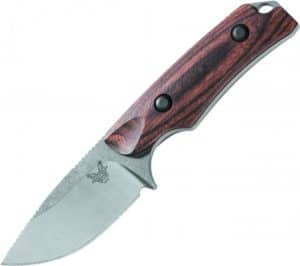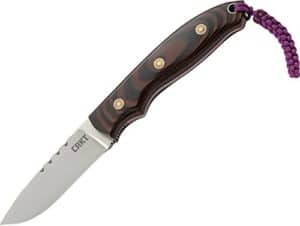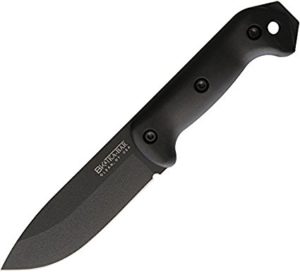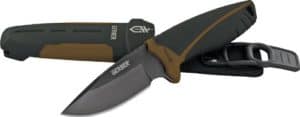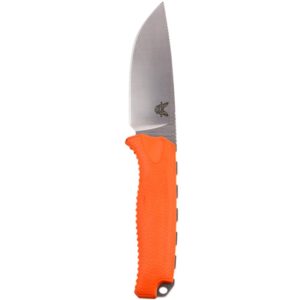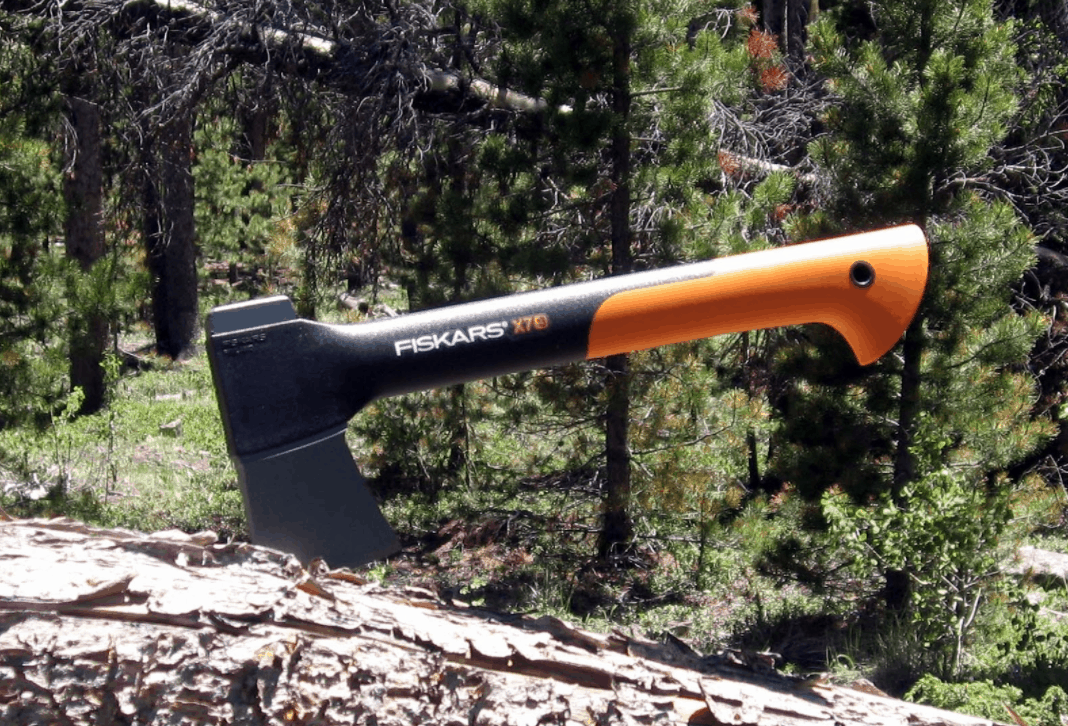Whether you’re hunting, fishing, scouting, or just camping, having a good knife at your disposal can sometimes mean the difference between life and death. Or the difference between having sliced cheese back at camp or having to break it off the block (which is why it is a staple on most bug out bag checklists).
Whichever camp you fall into, selecting the right hunting knife can be crucial to your success in the field. If you’re wanting a stainless-steel blade for use around the ocean, or you’re wanting a knife that will work for everyday use along with elk hunting, there’s a knife for you!
We’ve also included a buyer’s guide at the bottom of the article, with some more options to consider to help you find the perfect knife. It walks through a few things that are mentioned with the knives below, but goes into a lot more detail, so make sure to check it out!
Now, with that in mind, we’ve sorted through hundreds of knives out there to bring you the best; there’s a lot of variety in the knives below, but one thing is consistent, and that’s the quality of these knives.
1. Benchmade Hidden Canyon Hunter
For over 30 years, Benchmade has made quality knives, and the Hidden Canyon Hunter is no exception. With a full tang, stainless-steel bale and simple design, ti’s sure to perform in the field.
With its large-radius drop-point blade, it will excel at skinning and meat removal. Combined with Benchmade’s lifetime warranty, this is an excellent knife.
2. Havalon Piranta Z Folding Blade
With 2 ¾” replaceable razor-sharp blades, this is a great go-to skinner. Whenever it starts getting dull, simply replace the blade and get back to work! Features an open back design for easy cleaning, thumb studs and a liner lock. A good knife to have cutting gloves to use with; it’s that sharp!
3. Columbia River Knife and Tool Hunt’n Fisch
Designed by Larry Fisch, this knife is ready for your hunt. With spine ridges on the blade for blade control, 3” blade, and comfortable handle, this knife will help ensure you’re getting the most meat off your game.
It also features a lanyard hole in the handle. With a more stylish finish and handle than some other knives, it also comes with a great leather sheath that looks great with the knife. Perfect for someone who wants a great knife that also has some style.
4. Ka-Bar Becker Companion
Made as an all-around hunting and camping knife, the Ka-Bar Becker Companion is a tough knife that won’t disappoint. With a full tang blade, and an overall length of 10.5”, this is a robust knife that you can count on handling any camping and hunting tasks that you throw at it.
If you need a knife to make kindling with, or to just cut cheese around the camp, it’ll handle it with ease. It comes with a hard plastic sheath that’s MOLLE compatible.
5. SOG HuntsPoint
As leader in the manufacturing of tactical knives and accessories for years, SOG knows how to make a great knife. The HuntsPoint skinning knife is no exception, and would make a great addition for any hunter.
With a beautiful rosewood handle with a lanyard hole, a grip point designed into the blade, it’s going to be an easy to use knife that gets the job done. Featuring a 3.6” stainless steel blade matched with a leather sheath, this knife is a great asset.
6. Gerber Myth
Gerber is one of the few companies that has managed to walk the line of quality and cost very well. While not the top-of-the-line gear, it has good quality for the low price. And for those looking for a high quality, low cost hunting knife, look no further.
The Gerber Myth has a full tang, high-carbon stainless steel blade for excellent corrosion resistance. It also has a softer rubberized handle for excellent grip in any conditions. Comes in a drop point or gut hook style. Comes with a hard plastic sheath that has a built in sharpener.
7. Benchmade Steep Country
With a well-balanced, full tang stainless steel blade, the Benchmade Steep Country knife is a great choice for any hunter. Featuring a drop point and a molded kydex sheath with a snap closure, it’s sure to be ready for any situation. With Benchmade’s unyielding quality and lifetime warranty, you can be confident purchasing this knife.
8. Knives of Alaska Suregrip Bush Camp
9. Buck Knives Omni Hunter
For many years, Buck Knives has been at the top of the list of quality knife manufactures, making their knives in the USA. If you like your hunting knife with a gut hook, this is a great knife for you.
At 3 ¼”, this knife is perfect for skinning game animals, the steel blade has excellent strength and edge retention. With a curved, ergonomic handle with grip ridges, this knife is perfect to use in any condition. It also has a lanyard hole for easy securement.
As a dedicated hunting knife manufacturing company, Knives of Alaska creates some of the finest hunting knives available. The Suregrip Bush Camp knife is a strong candidate for any hunter looking to purchase a knife.
With an overall length at 10 ½”, this is a large, heavy duty knife that you can count on. With a full tang, stainless steel blade and a rubberized handle, you can count on this knife to get the job done. Paired with a high-quality leather sheath.
FAQs and Buying Guide
What are the different grind types?
There are several terms you’ll hear bandied about when it comes to hunting knives. One of them is ‘grind’. The grind in this case refers to the geometry of the blade edge itself. That geometry is vitally important in determining whether the knife will do what you want it to do. Let’s take a look at the major grind types:
The hollow grind – This is a concave (1) grind that produces an extremely sharp edge. You’ll commonly see a hollow grind on straight razors used by barbers. You’ll also notice that barber stropping his hollow grind blade all the time to keep it sharp. That’s because the super sharp edge also dulls quickly and needs constant upkeep. That said, if you plan on skinning game you’ll want to have a good hollow grind blade on hand (and a sharpener).
The flat grind – The flat grind curves neither inward nor outward as it tapers from the full blade width to the finished cutting edge. A short steep flat grind is a decent general purpose blade. While a more tapered flat grind can be used effectively for skinning game and other detail work. Like a hollow grind a long, tapered flat grind will need considerable maintenance to keep it sharp.
The convex grind – Convex is the opposite of concave. With the convex grind the blade actually bulges outward a bit as it progresses toward the point. As a result a convex blade is very durable. Much more so than a hollow grind or tapered flat grind. The convex grind is preferred for general purpose use, whether that’s harvesting wood, cutting rope, carving tent stakes, tapping trees for sap (2) or even starting fires.
Is it possible to change the grind type of my blade?
Absolutely. If you want you can switch from using your knife as a campground workhorse to using it primarily to skin game. To do that you’d just switch from a convex grind to a hollow grind or tapered flat grind. Just keep in mind that while you can change the grind of the blade on purpose, it’s also possible to change it accidentally. So anytime you sharpen your blade be aware of what type of grind you want it to have and then proceed accordingly.
What are the different blade shapes?
Just as there are different blade grinds there are different blade shapes. The different shapes are intended to serve specific purposes.
The drop point – This is the most common blade shape for hunting knives. This shape features a spine that falls away (drops) as it nears the tip of the blade. This allows the tip to be a little more pointed than if it didn’t drop. It also allows you to apply a bit more force to the blade. That pointed tip along with the large belly and relatively long blade make the drop point a good all purpose hunting/camping knife.
The clip point – The clip point is nearly as popular as the drop point. But the shape is radically different. With the clip point blade a scoop is taken out of the spine near the tip. This creates a very pointy tip that is good for detail work. However, you need to be careful when using that pointed tip because if you apply just a bit too much force it’s likely to break off.
The tanto – If you think the word ‘tanto’ has vague Japanese overtones you’re absolutely right. The original tanto was a type of Japanese Samurai sword (3) characterized by its short length that first appeared nearly 1,000 years ago. The blade was designed to allow for use in enclosed spaces where full-length Samurai swords were impractical. Today’s tanto blade evokes the profile of its historic predecessors. It’s typically short with a geometric blade that often abruptly angles upward near the tip. The tanto is very durable and a good choice for a heavy duty knife.
The sheepsfoot – The sheepsfoot blade is something of the opposite of the tanto. Whereas the tanto angles dramatically upward near the tip the sheepsfoot angles pretty dramatically downward. What’s the advantage of that? Well it allows you to bring a lot of force to bear on the blade for things like cutting wood. In the event of an injury it also allows you to cut away clothing while minimizing the chances that you’ll cut yourself in the process.
The trailing point – With the trailing point blade, the tip protrudes above the spine. That spine is curved to varying degrees (depending on the manufacturer) but always ends with the tip rising above the plane of the spine. The trailing point blade typically has the sharpest tip you’ll find. And they usually have some of the longest cutting edges you’ll find as well.
Keep in mind that if the SHTF any blade shape is the right blade shape.
How long should a hunting knife be?
The first thing to mention when it comes to blade lengths is that your state laws will likely have a thing or two to say about how long your hunting knife blade should be. So before you go spending a lot of money on a Crocodile Dundee (“That’s not a knife… THAT’S a knife!”) special make sure Johnny Law isn’t going to take it from you if they somehow discover it.
The most important thing to keep in mind is that your hunting knife should be an asset, not a liability. So it shouldn’t be too long because you need to carry it easily. In fact if you only plan to use it for some skinning and maybe gutting a few fish then the blade doesn’t really need to be much more than 3” or so.
If you plan on using your knife to build a blind or chop wood or whittle tent stakes and the like, you’ll want something longer. Maybe as long as 6”. But again, make sure a 6” blade is allowed both in the state where you live and where you’re going on your hunting trip (4). And don’t make the most common mistake people make with hunting knives and just assume that longer is better. It might be. Then again it might not be.
Can a hunting knife be used to pry things open?
Ideally, you should never use your hunting knife for prying. It’s the fastest and surest way to guarantee a broken tip. Of course if you’re in a situation where being able to pry something open will mean the difference between life and death, then by all means pry away. But in less than life or death situations the hunting knife should never be used for prying. If you think you might encounter the need to do some prying get a high-quality multitool (5) with a good solid screwdriver feature and save your knife for knife stuff.
What does it mean if a blade is ‘heat treated’?
The making of quality steel is a process that has undergone constant refinement over the centuries (6). Today, that process takes into account very precise chemical compositions that produce a wide array of different steel grades (7). But regardless of the exact grade of steel it must be heat treated or it would be essentially useless for knife blades. ‘Heat treating’ is a term used to describe the twin processes of hardening and tempering the steel. Hardening is a pretty self-explanatory term. While tempering causes subtle changes in the composition of the hardened steel. This removes much of the brittleness that results from hardening and makes the blade practically useful.
What’s the best way to sharpen a hunting knife?
It’s a good question but one that doesn’t lend itself to a single, simple answer. Perhaps the best way to sharpen your knife is to bring it or send it to someone who sharpens knife blades for a living. There are companies out there that will do it. You send them your knife, they sharpen it and send it back.
If you want to do it yourself you can try using a sharpening jig (8). This will hold the knife securely and at the proper angle so you can get just the edge you want. Other options include sharpening stones and electric knife sharpeners.
Sharpening stones tend to appeal to purists who enjoy the hands-on aspect of sharpening. A lot of hunters though, are using electric sharpeners these days. Even though they’re typically designed to handle kitchen knives, many of the best will also do a bang up job on hunting knives.
Choosing the Best Knife for You
When purchasing a hunting knife, it’s important to look at the different factors, and there’s a lot to consider.
First, what will the knife be used for? Is it going to be your all-around camping/hiking/hunting knife, or will it solely be used for skinning game? Will it be your EDC knife? If it’s for camping as well, try to find a knife that is going to hold up well to a variety of chores. If you want a dedicated hunting knife, find one that is specifically made for the purpose you have in mind.
Another feature that is preferred by many is a gut hook. It is a nice little feature on the tip of a blade used for skinning an animal very easily. It definitely is something to consider but isn’t a must have.
Will you be using it in saltwater areas? If so, you may want a stainless-steel blade instead of just carbon steel. Then there are different types of steel, and the Rockwell hardness scale. We won’t get into the types of steel, as there are many different types, and is an extensive subject. The Rockwell harness scale measures the hardness of metal.
A lower number is good for an ax or something along those lines, since there is a lot of impact on the blade. If the blade is too hard, it will become brittle and can shatter easily. So for a camp knife, look for a RHC number that’s medium. For a hunting knife, it’s recommended to go higher, but not too high.
Blade Types
For a quality knife, find one with a full tang blade. A full tang blade runs the length of the knife, even through the handle. This prevents the handle from breaking off the knife, and gives the knife added strength. Even though a full tang blade is knife, it isn’t crucial like it is with survival knives.
Also, consider the sheath that comes with the knife, as this is one of the main ways that you will interact with your knife. Leather sheaths are a premium sheath and typically are high quality and hold up well, but they have their drawbacks as well. They don’t weather as well as plastic, and may wear out sooner.
Hard plastic is very durable, holds up against the elements well, but typically doesn’t have a snap closure to keep the knife from coming out. So over time, the knife may start to come free from the sheath more easily. A nylon sheath would be one of the worst sheath options, as they are neither durable or aesthetically pleasing.
One option for replacing a cheaper knife sheath is to have a custom one made, but this can also be costly. A low quality sheath will be frustrating to deal with, and can be unsafe. Keeping these factors in mind will help ensure that you buy a quality knife that’s suited to the right purpose the first time.
Conclusion
When choosing a hunting knife, look for a knife with high quality materials, a hardness rating appropriate for the job at hand, a blade type that suits your preferences, and one that comes with a great sheath to protect your knife. We reviewed many different knives at many different price points. Some people don’t need a very expensive knife while others prefer something of high quality. Whatever your preference, be sure to pick a hunting knife that meets your needs and your budget.
